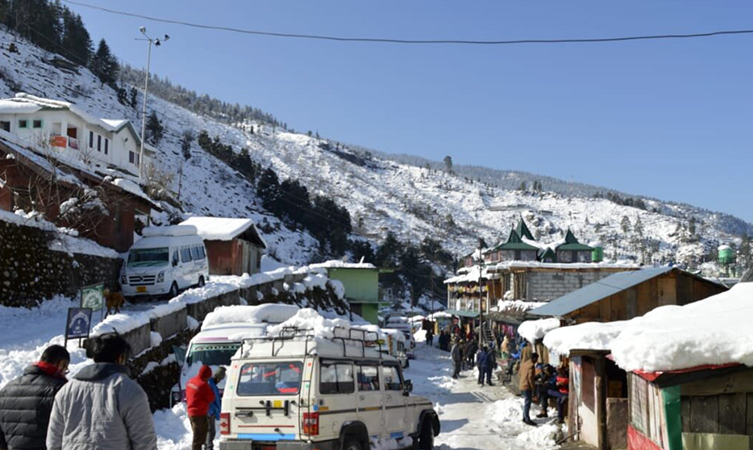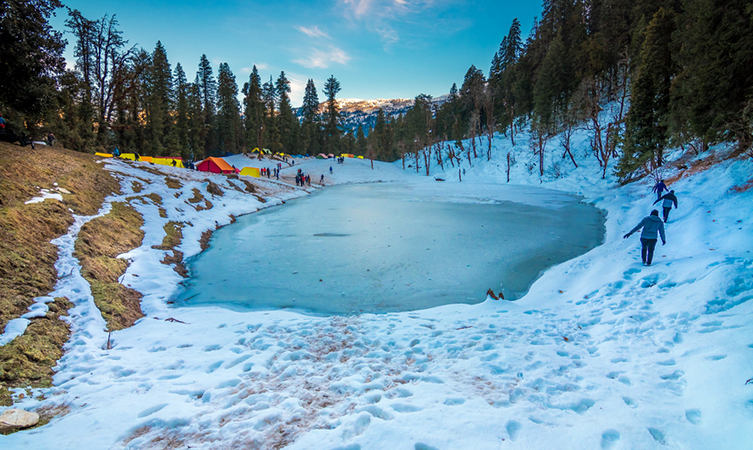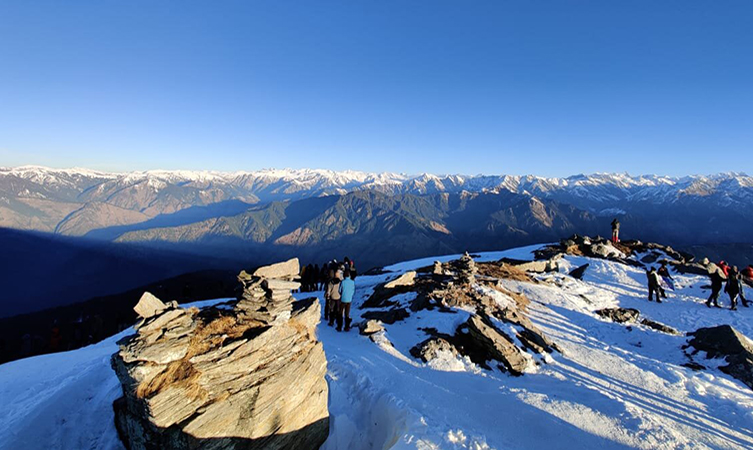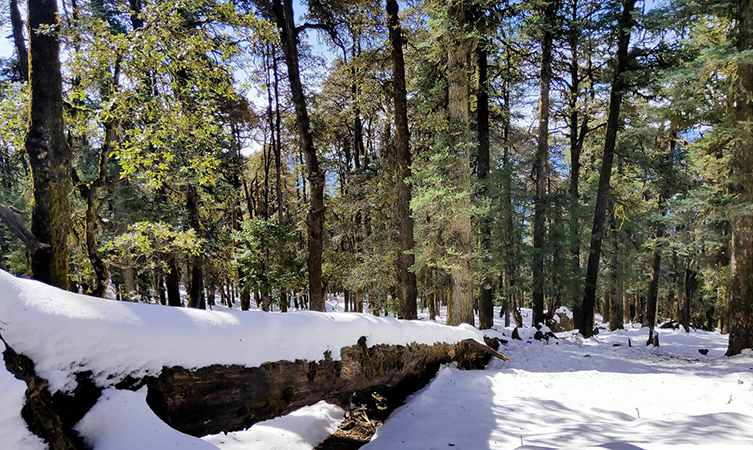We assure the privacy of your contact data. This data will only be used by our team to contact you and no other purposes.


Kedarkantha Trek is one of the easy to moderate summit treks to do in winter as well as in summers. One gets to experience a full 360 degrees view of the Himalayas. A trek that offers some amazing views in the day and through nights, sliding on soft snow, and a sense of accomplishing a summit at 12, 500 feet. This trek is perfect for someone who wants experience trekking in the Himalayas.
Kedarkantha Trek is part of the Garhwal Himalayas. This is a trek of 18kms with gradual ascends and descends. As per the local folklore, the Kedarkantha summit was the spot where lord Shiva had meditated for a long time. As he was leaving this place, he left his "Kantha-haar" meaning "zevar from the throat" at the spot. The locals mention that their ancestors had replaced it with a Trishul (Trident) which can still be found at the summit.
Show MoreFor a full refund, cancel at least 24 hours in advance of the start date of the experience.

Reach Dehradun railway station by 06.30am and assemble at the pickup point. We start the drive from Dehradun railway station by 7 am with a halt for breakfast on the way and lunch at Purola by 1.30pm.
We should reach Sankri by 4.30pm and check into the homestay / guesthouse / campsite.
At around 7pm we have a team briefing with soup & snacks in which we get to know each other better. We will share the plan of the trek routes, evacuation strategies, picture moments and more.

Today, we start at 8.00am from Sankri. We walk along the road for 15 mins and take the trail starting from the right.
We cross a cement bridge after an hour of the trek and rest for bit. Another hour of ascend and we reach a clearing where we will have hot lunch at campsite. After lunch we will have acclimatization walk for about an hour and reach a second clearing from here, we will be back. We do some cool down session and enjoy the rest of the day.

We start at about 7am from Janyola. Right after crossing the lake towards our left, we take the trail above it. This trail leads us straight to the Kedarkantha base. This is going to be an ascend through dense forests and clearings.
From here, we can see the Kedarkantha summit right in front of us. We will have an early dinner and sleep.

Today we start early. We aim at starting the trek by 5 am to get a complete view from the top with the sunrise.
We reach the Kedarkantha Summit by sunrise. After spending 20 mins and enjoying the breath taking 360 degrees Himalayan views, we start to descend. On reaching the base, have lunch by noon and start packing. Post lunch, we start our descend to Janyola and reach by 5pm. We enjoy a hot serving of soup with an early dinner and sleep.

We start the day with light refreshment as early as possible to make it to Sankri by before 8 AM. We start to descend to Sankri by 6am. We trek through the forests once again to get down to the cement bridge we had crossed on our trek from Sankri to Janyola. From this cemented bridge, we follow the same trail that gets down to Sankri. We will have breakfast here and have lunch on the way to Dehradun. We can then to proceed to the bus stand or the railway station.

We assure the privacy of your contact data. This data will only be used by our team to contact you and no other purposes.
Winter sets in this region by the mid of December till the mid of February. The first snowfall typically can happen anytime in the early days of December
Often the months of January and February are the best months to do the Kedarkantha Trek.
Usually, the month of December is very crowded with Christmas and New Year Holidays making it
convenient for many office goers and college students to get leaves. However, the months of January
and February are some of the best times to do the Kedarkantha Trek.
During the month of January and February, the Kedarkantha trek route is very less crowded and the
trail typically remains completely under snow.
Less crowd makes it a great trek experience as it sets the appropriate ambiance and solitude of a
Himalayan Trek. It lets you capture good photographs and also works out to be ideal for wildlife
sightings.
Often it works out to be a great adventure as in the month of January, it snows for 2-3 days
continuously. While this calls for a great adventure, it might disrupt your schedule at the same time.
Do keep a few buffer days on hand while you plan this trek, especially between the end of January till
the end of February.
Our teams have submitted the Kedarkantha Peak many times in these months and we see no reason
why you cannot be able to do it.
However, you do need a good, strong, and positive support team to work for you. Sometimes we did
face disruption which we managed by waiting for a day or two and then doing the same trek to
complete it in style
The Kedarkantha Trek falls in the Jaunsar region of Uttrakhand bordering the Kinnaur belt of Himachal Pradesh.
This region lies at the juncture between the Great Himalayas and The Dhauladhar range and receives
an immense amount of snowfall during the winter months from December to March.
Sometimes, it even snows here out of the schedule like in the months of April, October, or November
too. However, they disappear very soon with the bright sun melting off the snow.
The snowfall that happens in the months of December remains for as long until the end of March.
The cold weather of the winter prevents it from melting, whereas fresh snowfall keeps on piling over
it making it a snow wonderland.
Typically, it can snow anytime in December till March, and many trekkers and local people wait eagerly
for it. Good snowfall brings prosperity to the village. It results in a good apple season in the coming
months and also good earning opportunities for the local trek guide and porters.
If you read the internet, you will feel as if the Kedarkantha trek is full of snow all around the year.
However, it's not true. It snows in this region during the winter months of December and goes on till
the mid of March. The snow starts to melt starting the end of March and after the mid of April, the
trek becomes green and colorful with blooming flowers. During the winter months from December till
March, the trek remains under snow cover and the visual sight is one of the rarest in the Himalayas
and referred to by many trekkers as the most beautiful trek in the Himalayas
currently, there is about less than half feet of snow from Kedarkantha Base Camp till summit, but with one snowfall it will be 2-3 feet of snow covered.
Kedarkantha Trek is freezingly cold in the winter months from December till March. During the winter months when the trek is full white because of snow, the temperature dips down below freezing point and goes to as low as -10 degrees on the top of the summit at midnight or at dawn. However, the temperature inside the tent is around 3-4 degrees depending upon how many people share the tent. Daytime temperature during the winter remains around 8 - 12 degrees. We need to be mindful that when sunlight reflects on fresh white snow above 3000 meters, it can get quite warm and even hot at times due to the reflection of UV rays. On a bright sunny day, even in the winters when there is snow all around, the temperature can reach up to 20 degrees due to reflection. We need to protect ourselves not just from the UV rays but also from frequent temperature changes and sweating.
Anyone who is generally fit with no cardiac problems should be able to complete the Kedarkantha trek without any problems. When we say 'Generally Fit', we mean he/she should be able to run a 6 km marathon and should be able to complete it. He need not come first. Just be able to complete it. Having strong legs, shoulders and core strength helps a lot. You may do staircase climbing with or without weight to train your legs. Cycling, Swimming, or brisk walking should help build stamina. Plank helps strengthen your back and core. A few push-ups and chin-ups should strengthen your shoulders and back muscles. Do note that you need not be a champion in marathon running or a bodybuilder. You just need to have a positive mindset and a generally fit body used to exercise.
The Kedarkantha trek is perhaps one of the best treks for beginners. It is a multi-day Himalayan trek that involves camping and surviving extreme conditions of snow and cold. On any good Himalayan trek that goes higher and above 4000 meters it becomes very important that you are well accustomed to camping and sustaining discomfort for multiple days. Kedarkantha trek just gives you a crash course for the same. The walks on each day are planned to be shorter, there is an ample amount of snow but we keep no stone unturned to give you comfort even during that extreme temperature and wilderness. It is about managing the adventure under the safe hands of experienced trek leaders. We do exactly the same. We hone your trekking skills while on the trek, to make you a better trekker, and to make you love and care for the Himalayas, just as we do! With our planned trek, safety instructions, and fitness guidelines, anyone who is generally fit, should be able to complete the Kedar Kantha trek without any problem.
This route is very safe with respect to AMS as the sleeping altitude on the entire trek is below the tree line with a natural oxygen supply. On top of it, we are always prepared for any untoward symptoms with our special medical team to take preventive actions based on the symptoms. In most cases, the problems are the result of indigestion and cold, smoking, or drinking on the trek.
Trail Safety:
Yes - Kedarkantha Trek is very safe, but only when done under a responsible and alert
guide. Or else, this trek can go wrong for many. A twisted ankle, fractured hand, wrist, leg, etc are
something that ignorant and irresponsible trek guides have shown to us in the past. In fact, a trekker
under the supervision of one of the most popular, largest and pioneer trek companies in India have
even died on this trek route. All thanks to the ignorant trek leader. Sometimes, even a few trek leaders
have returned with a frostbitten leg on this trek. It is common to get lost in the jungle on this trek
route. So, this historical data does reflect that this trek is easy, but needs to be done under good
supervision and a responsible trek company.
We have not had a single case of even a twisted ankle on any of our treks. All thanks to our experienced
team, well-planned adventure, strict discipline, and mountaineering principles.
Excessive Snowfall: It is typically very common in the month of February to receive excessive snowfall
for continued days. Many times, it snows bad when treks are still on. While you are in the tents, it is a
possibility that the tent might break if you don't keep clearing the snow to pile on the top. We require
a swift response at that time and hence the trekking company you chose to trek with matters a lot.
With Himalayan High, you will be advised what to wear and our team is a professional and experienced
team to handle these issues.
High Altitude and AMS: The Kedarkantha trek route is very safe from Altitude Sickness. If you are fit
and have the desired stamina, you may even climb the peak in a matter of 2 days. all of the camps on
this trek have natural oxygen from trees. The highest altitude of this trek is 3800 meters, which is not
the sleeping altitude. The highest sleeping altitude is 3000 meters and below the tree line where
natural trees give out fresh oxygen. However, on our managed treks, we carry oxygen cylinders with
us as a precautionary safety measure and monitor the health of all the trekkers every day.
Emergency Exit: There is no alternative way out on this trek route apart from either trekking back to
Sankri or bringing an injured trekker down on the back of a horse. On reaching Sankri, cabs can be
managed.
Water on Trek:Water is a very important element on any trek. Wrong water intake can cause you to
withdraw from the trek and be hospitalized as well. On any Himalayan trek, natural water sources like
lakes and streams are the only option. We serve stream water boiled, filtered, and then treated with
oxidizing agents like chlorine or iodine. Till now we haven't had any bad experiences with water.
Women's Safety:It is typically very safe for women in the Himalayas. The locals respect them and
treat them well. We haven't yet heard of any stories or incidents of bad treatment of women in this
region. However, it must be noted that local culture and sentiments must be respected.
ATM and Cash Points: There are no ATMs or rather any banks in Sankri. Purola - 70 Km below Sankri is the last place that you can trust to withdraw some cash from ATM. Else, it is advisable you withdraw it from Dehradun or Mussoorie.
Mobile and Internet Network in Sankri: The mobile network is very good in Sankri as JIO has started, apart from Jio there are mobile towers for BSNL and Vodafone also. On the trek route, there are points including the summit from where you can make calls. However, it does not work most of the time. It is better to inform your family members accordingly so that they do not panic when you aren't reachable on phone. Once you leave Purola, Only JIO, BSNL, and Vodafone are available. Sankri is the last point which is where you may get internet on Jio 4G most of the time. After that do not expect the Internet on your mobile.
Although these days weather has become very unpredictable, Kedarkantha peak usually gets its first snowfall by the mid of December. This belt of the Himalayas gets heavy snowfall and often the first snowfall is heavy. This can make the entire trek a snow merry-land right with the first snowfall.
Yes, Sankri too gets snowfall and turns completely white. Usually, that happens after mid of January or early February.
Kedarkantha trek can be done throughout the year but the beauty of it is in its snow which turns the trek into a white dreamy land and cold. The entire excitement of this trek comes from the snow and tolerating cold for 4 days of the trek. We camp over snow for all these days. Also, it's a good way to celebrate your New Year and Christmas. Snow makes this trek a little moderate, otherwise, it's a straightforward easy trek of 24 kilometre.
Kedarkantha trek is the best trek for a beginner, especially in the winter. It provides you with all the elements that make it a perfect trek to start your Himalayan sojourn.
Not really, but a walking crampon will make this trek easier for you. If you have good high-ankle waterproof shoes (not woodland) which have good traction, specially Vibram soles, you really do not need a crampon. However, walking over the snow without crampons for a beginner becomes a tough task and you can slip frequently. Sometimes, slipping can hurt you or twist your ankle. So, a walking crampon is advisable.
Everything can be provided by us on special request and extra charges.
We take immense care in providing a very hospitable and sometimes our trekkers call it 'luxury' on this trek which helps in combating the cold. To start with, firstly we provide mattresses that are about an inch thick, and we are the only organization that provides such expensive mattresses on this trek. The sleeping bags which we give are very good to be used for sub-zero temperatures along with a fleece liner for that extra warmth and hygiene. Since we cannot wash sleeping bags often, it's very easy for us to wash liners easily. We give more liners to ones who feel colder. This increases the layers and makes it warm and cozy. We also recommend bringing hot water bags, which we fill with hot water and can be taken inside the sleeping bags to act like a heater. Supported with a well-insulated dome tent, it makes it very comfortable for you to sleep, even on top of the snow. So, all the arrangements will be taken care of keeping in mind the cold and that it's a beginner's trek. However, there should be a positive spirit to face all the adventure despite our equipment and arrangements. You can also use warmers - self-heating powders. This powder pouch can be bought from our store at 100 Rs. per pouch.
Yes. Waterproof shoes will help keep your feet dry and safe as you trek through the snow. Often there will be snow poling due to which your feet will go deep in the snow. You need to wear a gaiter over your shoes to protect snow from getting inside your feet from the top.
Not a mandatory thing but having it will help you with better balance and prevent jerks on your knees. Using a trekking pole is more of a habit. If you have strong legs, it is not required. It will keep your hands free with which you can save yourself from a fall or maintain balance. Using a trekking pole requires extra effort.
Yes, there are many shops that give gear on rent, but depending on the availability if you are planning in winter you should plan with enough margin time for preparing yourself in Sankri.
The cheapest way to arrive Sankri is by taking a bus from Dehradun to Sankri and the same on return from Sankri to Dehradun. Buses leave both destinations early morning at 5:30 6:30 and 7:30. From Dehradun to Sankri can be bought it from the Mussoorie bus stand near Dehradun Railway Station. You need not pre-book these buses. Compared to a small vehicle, traveling by bus takes longer time - approximately 10 to 11 hours. One-way fare between Dehradun and Sankri is about 300 Indian rupees. Show the two-way fare comes down to about 600 rupees.
Yes. Shared jeeps can be taken from Dehradun to Purola and then from Purola to Mori. From Mori, shared Jeeps can be taken further to Naitwar and then from Naitwar to Sankri. Traveling by shared jeep increases dependency and is time-bound. You can get a shared jeep to Purola from Dehradun till 3 pm. It takes about 4 - 5 hours to reach Purola on a shared jeep. If you are too late then from Purola you will not get any means to reach Mori and further. Hitch-hiking is an option but not guaranteed always. Vehicles to Mori can be got latest by 3 PM from Mori, and that too with difficulty. If you reach Mori at odd hours, you can reserve a vehicle to drop you at Sankri. They will charge about 1000 to 1200 depending on the time. From Naitwar, if u reserve a cab to Sankri, it will cost you between 500 to 700 Rupees.
Yes, usually.. but during the peak winter season, there is a tremendous shortage of rooms and further good rooms in Sankri. People even camp in Sankri due to a shortage of rooms. It's better you pre-book your rooms if you are trekking during the peak winter season. If you are hiring a trek operator like us or other reputed ones, they will include this in their package.
NO. Sankri does not have ATMs. Please carry excess cash with you for this trip. The last ATM point is Mori (SBI). Purola has more options for ATMs. However, we recommend you bring all your cash from Dehradun itself or Mussoorie. ATMs after that do not guarantee you money. Often they are out of service.
If you are a fit Trekker, then you can complete this trek in 3 days from Dehradun even during the winter. However, that means that all of your travel is optimized and you need not depend on any third party. You can rent all the trekking and camping gear from Sankri, hire a porter and get this trek done in style. However, if you are a beginner, then we recommend you hire one to organize.
No, but only if you understand well what you mean and want to do. We promote self-sufficiency, but not for the sake of it. Even if you have good experience in other mountainous terrains, and well understand the art of surviving in the wild and outdoors, you can well do this trek with your own expertise. Also, it's very unlikely you will be left alone on the trek if you are trekking during the peak winter season. You can rent all trekking and camping gear from us. Even porters if you need them. Hiring a porter will help you with some local assistance throughout the trek.
We start early morning for the drive from Dehradun to Sankri, at around 730 AM. So it's advisable to
reach Dehradun by 7 AM. The best way to reach Dehradun is by taking an overnight Volvo bus from
Kashmere Gate ISBT in Delhi. The last Volvo leaves at 1130 and reaches Dehradun ISBT by 530 in the
morning. There is also a train AC Express which reaches Dehradun at a good time.
You can book them online at https://utconline.uk.gov.in
We coordinate and arrange for easier transportation between Dehradun and Sankri. The group sharing the cab pays the travel fees to the driver. For efficiency, we fix the pickup location and that will be Outside the Dehradun Railway Station. The pickup timing will be between Morning 730 to 8 AM. The current cost is as listed below: For small vehicles (Bolero, Mahindra Max, or Similar), the price is 7500 * 2 = 15,000, which can be shared by 7 - 8 people. For tempo travelers, the cost is 11,000 * 2 = 22,000 and can be shared by 9 - 13 people
One can start early morning around 7 AM on the 6th Day from Sankri and it takes about 8 hours to
reach Dehradun considering ideal situations and lunch breaks. However, it is advisable to keep a buffer
time of about 3 hours as it is a mountainous road. So you are expected to reach Dehradun from Sankri
at 3 PM and considering the Safe Buffer Time, you should book your return tickets only after 6 PM
from Dehradun.
If you are traveling to Delhi from Dehradun, then you will get many buses that leave from ISBT. It's
better if you pre-book, but that's not mandatory if you are not very particular about the bus service
and quality. Usually, they are good.

Interdum et malesuada fames ac ante ipsum

Westminster Borough, London

Westminster Borough, London

Westminster Borough, London

Westminster Borough, London
Leave a Reply
Your email address will not be published.
Location
Staff
Cleanliness
Value for money
Comfort
Facilities
Free WiFi